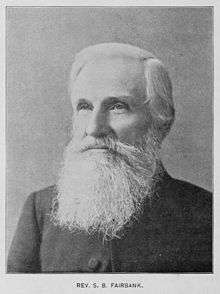Samuel B. Fairbank

Samuel Bacon Fairbank (December 14, 1822 – May 31, 1898) D.D. was an American evangelist, writer, translator, and amateur naturalist who worked in India with the American Marathi Mission in western India, mainly in Wadala Bahiroba, near Ahmednagar. Fairbank was responsible for some of the earliest translations of hymns into Marathi. He also worked on a number of initiatives to improve agriculture. Many of his children continued to work as missionaries. Trochalopteron fairbanki, a bird, Fairbankia and Achatina fairbanki, molluscs are named after him.
Biography
Samuel was born in Stamford, Connecticut, the eldest son of John Barnard Fairbank, principal of a school. The family later moved to Massachusetts where they manufactured straw hats. Fairbank studied at Illinois earning an A.B. in 1842 and an A.M. in 1845 followed by studies at the Andover Theological Seminary. He was ordained D.D. in 1845. Shortly after marrying Abbey Allen (died 1852), the couple moved to India to join the American Marathi Mission in western India. His work was mainly at Ahmednagar (1846 to 1850 and again from 1871 to 1879), Bombay (1850 to 1857), Wadala (1857 to 1871) and from 1889 at Kodaikanai in South India. He visited the United States on three furloughs.[1][2]
Fairbank spent much of his time on evangelism through working with the local people. He taught agriculture and attempted to introduce more efficient practices and implements. He was also into music, translating hymns and transcribing them to make it suitable for local use, composing songs and teaching communities.[1] In his spare time, he also took an interest in natural history, making collections of molluscs, birds and plants.[2] He wrote notes in the Gazetteer on natural history and his publications on the topic included a "Key to the Natural Orders of Plants in the Bombay Presidency", "Popular list of birds of the Bombay Presidency with Notes", "A list of the Birds of the Palani Hills, with Notes",[3] "List of the Reptiles of the Bombay Presidency, with Notes" and "list of the Deccan fishes, with notes".[2][4] He collaborated with other naturalists including William Thomas Blanford who named a genus of a mollusc Fairbankia after him although it is now a synonym of Iravadia. Achatina fairbanki was named after him by William Henry Benson.[5] He also corresponded with Allan Octavian Hume.[6] Blanford also named Trochalopteron fairbanki after a specimen collected by Fairbank from Kodaikanal.[7]

With Abbey he had three children, two of whom died young. Emily Maria became wife of Rev. Thomas Snell Smith of Sri Lanka while Mary Crocker and John Melvin died young. After the death of Abbey in 1852 he married Mary Ballantine in 1856 (she died in 1878). They had daughters Anna (married Robert M. Woods), Katie (married Robert Allen Hume[8]), Elizabeth (married William Walter Hastings), Rose (born 1874, married Dr Lester H. Beals), Mary Darling (a missionary who married T. A. Evans) and Grace (married H.M. Burr); sons Henry (born 1862) and Edward (born 1867) who became missionaries. Henry was also interested in ornithology and wrote Birds of Mahabaleshwar (1921);[9] two sons Melvin and James died young.[1] Edward along with his wife Marie Lively established the James Friendship Memorial Hospital at Vadala in 1938. It is also known as the Fairbank James Friendship Memorial Hospital. Rose and her husband Dr Lester Beals established the Willis F. Pierce Memorial Hospital in Wai, Satara District.[10]
Samuel Fairbank died, possibly of heat stroke, while on a train to Kodaikanal on May 31, 1898. He was buried at Ahmednagar.[1]
References
- 1 2 3 4 Trafton, Jennifer M. (2005). "The Legacy of Samuel Bacon Fairbank" (PDF). International Bulletin of Missionary Research. 29 (3): 144–149.
- 1 2 3 Hume, Robert A. (1896). "The semi-centennial of the arrival of Rev. Dr. Fairbank". Missionary Herald. 92 (12): 526–529.
- ↑ Fairbank, S.B. (1877). "A list of birds collected and observed on the Palani Hills". Stray Feathers. 5: 387–410.
- ↑ Fairbank, S.B. (1876). "List of birds collected in the vicinity of Khandala, Mahabaleshwar and Belgaw, along the Sahyadri Mountains; and near Ahmednagar in the Dakhan". Stray Feathers. 4: 250–267.
- ↑ Benson, W.H. (1865). "New land-shells from Travancore, Western and Northern India". Annals and Magazine of Natural History. 15 (85): 11–15. doi:10.1080/00222936508681753.
- ↑ Nevill, Geoffrey (1884). "Handlist of the Mollusca in the Indian Museum, Calcutta. Part II. Gastropoda". Calcutta: Indian Museum: 99.
- ↑ Blanford, W.T. (1869). "Ornithological Notes, chiefly on some bird of Central, Western and Southern India". Journ. As. Soc. Beng. 38: 175.
- ↑ Anon (1929). Obituary Record of Graduates of Yale University 1928-1928. Bulletin of Yale University. (PDF). pp. 27–30.
- ↑ Anon (1927). Obituary records of Yale graduates 1926-1927. Bulletinof Yale University (PDF). pp. 324–325.
- ↑ "Guide to the Fairbank Family Papers, 1837-1971". Duke University.